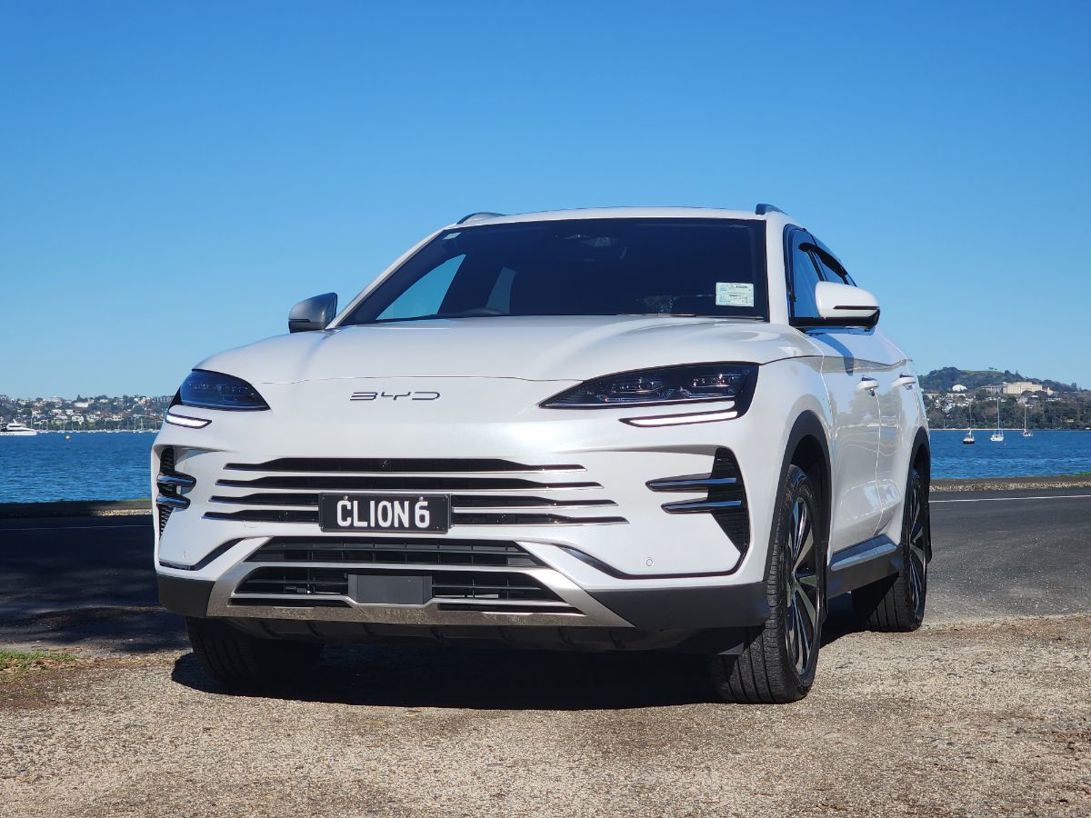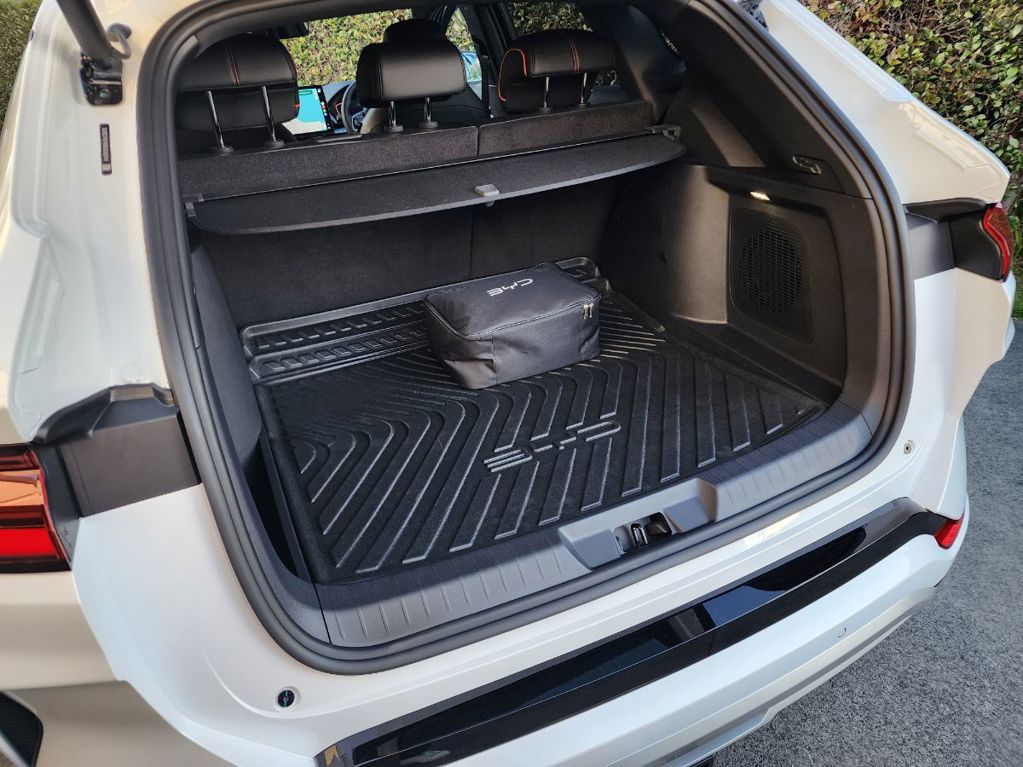Compared to the out-there design aspects of the Dolphin and Atto 3, BYD’s new Sealion 6 looks like a thoroughly conventional family car.

That’s probably how it needs to be. As a medium SUV with hybrid power it’s competing in a very mainstream segment, so it needs to appeal to the broadest possible range of people in the broadest possible way.
Seems to be working so far. For the first quarter of 2024, the BYD Song Plus (the Sealion 6’s name in the Chinese market) was the second-biggest-selling EV in the world, behind the Tesla Model Y.
To be fair, that figure includes both the full-electric and plug-in hybrid versions, and we only have the latter here. But this BYD is doing the business by any measure.

While the outside is quite conservative, underneath the Sealion 6 has some pretty clever hybrid technology. BYD calls the petrol-electric powertrain DM-i, or “super hybrid” if you prefer something more snazzy sounding. It’s the same tech that’s used in the forthcoming Shark 6 ute.
It can run as an EV, a range-extender or a full hybrid. This is do-it-all electrified technology.
The main difference between DM-i and most other hybrids is that the Sealion 6 puts electric first in every driving scenario, with petrol only used for assistance when needed. Key to that is a big 18.3kWh battery, which gives it 92km EV range.

The Sealion can operate in pure-electric mode, just like any other PHEV with enough charge, or indeed a battery electric vehicle (BEV). It can run as a range-extender, like the Nissan X-Trail e-Power: the electric motor drives the wheels and the petrol engine acts as a generator, making electricity. Or it can act as a parallel hybrid like a Toyota RAV4, the electric motor and petrol engine driving the wheels together.
If DM-i sounds complex… it is. But there’s really nothing for you to do except drive the car and plug it in when you can.
But the electric motor drives the wheels 100% of the time; it’s always connected.

Really, the closest rival on paper is the Mitsubishi Outlander PHEV, which is another PHEV (X-Trail and RAV4 are non-plug-in hybrids) and offers similar battery size and electric range. But as a hybrid, it still places more emphasis on petrol.
It’s delightfully quiet around town, and we don’t just mean the electric power: the cabin is beautifully isolated from outside noise.
The Sealion 6 is available as a FWD model, which is the one you see here: the $57,990 Dynamic. It pairs a naturally aspirated 1.5-litre engine with a single electric motor, for a combined 160kW/300Nm.

The $64,990 Sealion Premium AWD is actually a very different machine. While the FWD has an Atkinson Cycle engine (more efficiency at low speed), the AWD has a turbocharged Miller Cycle engine (more efficient at higher speed) and makes 238kW/550Nm. It’s a lot faster: 0-100km/h in just 5.9 seconds, compared to 8.5 for the FWD. And it can tow more: the rating rising from 750kg to 1300kg.
But you do also lose a little range with the AWD: the official figure is down 11km, to 81km.

Other than that, the generous interior specification is pretty much the same across the two, except for the Premium’s head-up display.
If DM-i sounds complex… it is. But there’s really nothing for you to do except drive the car and plug it in when you can - but know that you can keep driving regardless, because it’s a hybrid with a petrol tank.

If you must, there is some stuff to fiddle with. There’s an EV/HEV mode switch (as well as conventional Eco/Normal/Sport/slippery stuff settings) and if you delve into the Sealion’s luscious big 15.6in screen you’ll find a slide control where you can set the minimum state of charge for the battery, between 25-70%.
It’s delightfully quiet around town as an EV, and we don’t just mean the electric power: the cabin is well-isolated from outside noise and even if the petrol engine is ticking over charging the battery at idle, you can hardly hear it.

Keep it in EV mode and the Sealion 6 sticks determinedly to electric, even when you accelerate firmly. It takes a sustained push on the throttle to wake up the petrol engine.
We charged the Sealion to 100% several times during our week and got a pretty consistent 87km range, which is not far off the official figure. The Sealion 6 also comes with vehicle to load (V2L) capability, with the adapter standard.

The big battery does take some charging and it’s limited to 7kW for AC - which is fine for a wallbox-type home unit because that’s what they serve up.
The Sealion 6 also has a DC fast-charge facility, which means you can plug it in at a public station. Handy, although peak speed for that is 18kW and of course it won’t charge at that rate constantly; expect it to ramp up and then slow down as it gets full; we tried it a couple of times and you’re still looking at an hour if you’re starting from 25%. But nice to have the choice when you have such a big battery.

That battery also means you’re making the most of the Road User Charge (RUC) situation, because you’re paying the lesser PHEV fee but using the absolute minimum amount of petrol.
From a powertrain point of view, the Sealion is a good EV. It’s a good range-extender. It’s a good petrol-electric hybrid. It’s good at all of those things individually. If there’s anything to complain about, it’s in the transition between those modes; if you’re hustling along in EV mode and need maximum grunt, there’s a discernable pause between you asking the question and the car waking up the petrol engine.

But really, it’s not that kind of car. In steady-state open-road driving it feels pretty well sorted, with substantial steering and a chassis that gets on with business. It’s only when you press on a bit that the Sealion 6 starts to suffer waves of pitching. It’s not terrible, but it’s enough to remind you that this is not a sports SUV.
It is a luxurious one, though. The interior boasts some impressively high-quality materials and there’s the signature BYD massive infotainment screen, with ridiculously crisp and colourful displays and the ability to swivel between landscape and portrait - although as with other BYD models, phone projection (wireless for Android, wired for Apple) only works in the former and the display tends to disappear in portrait if you’re wearing polarised sunglasses.

The standard brown upholstery with orange piping looks pretty cool, but if that’s not your thing the Premium AWD also offers the option of BYD-trad blue and grey, like the Atto 3.
It’s a spacious family machine with excellent rear legroom, although there’s curious little space to put your feet under the front chairs. However, the flat floor is a plus.

There’s a curiously small rear window too, although visibility is taken care of by a staggeringly good 360-degree camera system.
If the Sealion 6 is lacking anywhere in terms of practicality, it’s the boot. Cargo volume of 425 litres is merely okay for a car of this size and the narrow, shallow shape isn’t ideal - nor is the huge step up for load-through when the seats are folded. That’s all opportunity cost for packaging all that electric hardware.

In terms of quality, clever technology and sheer efficiency, it’s hard to fault the Sealion 6. It’s not the last word in driver appeal, but there’s a confidence and coherence to the way it goes about business that will be a real draw for many.
With the battery-electric market in a cool-down phase, it’s a good time for a new PHEV. But pure-electric is also very much BYD NZ’s thing and yes, there will be a sister BEV to this car.
Not the electric Song Plus/Sealion 6 as it stands in China, but a new-generation model that will be launched as the Sealion 7. And even later, a 7-seater to be called the Sealion 9.
ENGINE: 1.5-litre petrol 4-cylinder with plug-in hybrid system, 18.3kWh battery POWER: 160kW/300Nm (combined), electric motor 145kW/300Nm GEARBOX: Single-speed, FWD 0-100KM/H: 8.5sec CONSUMPTION: 4.8l/100km (battery at 25% charge), 1.1l/100km (battery at 100% charge), EV range 92km. DC-charge compatible, max charge rate 18kWh (DC). PRICE: $57,990.
What are the key statistics for the BYD Sealion6 Dynamic?
The Dynamic FWD pairs a 1.5-litre naturally aspirated petrol engine with a large 18.3kWh plug-in battery to form the "DM-i" hybrid system. It has 92km of EV range but can also operate as a series (range extender) or parallel (both petrol and electric drive the wheels) hybrid. Combined power is 160kW/300Nm.
Is the BYD Sealion6 Dynamic efficient?
As with any PHEV, it depends how you use it. But with that 92km EV range (we consistently got 85km-plus in real-world driving), you could drive this as an electric car most of the time.
BYD's figure of 4.8l/100km with 25% battery charge (the minimum the car will allow) is a good indication of what you could achieve even if you don't plug in.
Is the BYD Sealion6 Dynamic good to drive?
In normal driving it feels very well sorted, with substantial steering and good chassis control. It's less happy at higher open-road speeds; body roll is supressed but it does pitch around a bit in bumpy corners.
Is the BYD Sealion6 Dynamic practical?
The cabin is generously sized and there's plenty of leg and headroom in the back. Where it falls a little short by class standards is a narrow/shallow boot (425 litres); there's also a fair step up from the boot floor to the folded back seats if you're carrying longer items.
What do we like about the BYD Sealion6 Dynamic?
The hybrid technology is very clever and fairly seamless for the most part: truly a do-it-all system that exploits the full potential of electrification.
The cabin is luxurious and lavishly equipped; we even love the brown-and-orange upholstery. Infotainment is excellent and the 360deg camera system is beautifully clear.
What don’t we like about the BYD Sealion6 Dynamic?
The cameras/screen need to be good because the rear window is tiny. The boot is a bit small and the hybrid powertrain can feel a bit fussy if you're on and off the power on the open road.
What kind of person would theBYD Sealion6 Dynamic suit?
A family SUV buyer who wants to maximise their electric motoring, but isn't willing to put all their eggs in a BEV basket just yet.



























